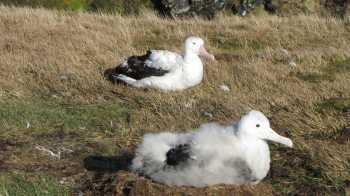Graham Parker (Parker Conservation, Dunedin, New Zealand) and colleagues have published in the journal Antarctic Science on the population of Near Threatened and ACAP-listed Grey Petrels Procellaria cinerea at New Zealand’s Campbell Island.
“Populations of grey petrels have declined globally due to both incidental capture in commercial fisheries and predation by introduced mammals at breeding sites. In the New Zealand region, grey petrels only breed on Campbell and Antipodes islands. Rats were successfully eradicated from Campbell Island in 2001.We assessed the spatial extent and conducted the first quantitative population estimate of the grey petrel population on Campbell Island and surrounding islets. There was an estimated c. 96 pairs (95% CI: 83, 109) of breeding grey petrels from the four colonies. Since work was conducted during the middle of the chick-rearing stage, this is an underestimate of the breeding population. The Campbell Island grey petrel breeding population remains small. Our study provides a baseline for future population estimates of grey petrels on Campbell Island.”

Graham Parker surveys Grey Petrels on Campbell Island
Read more on the survey here.
Reference:
Parker, G.C., Rexer-Huber, K. & Thompson, D. 2016. Grey petrel population on Campbell Island 14 years after rodent eradication. Antarctic Science doi:10.1017/S0954102016000626.
John Cooper, ACAP Information Officer, 27 February 2017

 English
English  Français
Français  Español
Español 

 R. Wanless & A. Angel.jpg)
